|
|
||||||||||||||||||||||||||||||||||||||||||||||||||||||||||
Berman Foundation opens to raves
|
|
Berman Foundation opens to raves
New
Berman museum-offices open to raves
By Tom Ineck
LINCOLN, Neb.—More than 1,000 people
visited The Burkholder Project in just
two hours during the April 3 First
Building owner and artist Anne
Burkholder said the attendance exceeded
all expectations. The previous record
for a gallery walk was about 600 people. She attributed the
huge increase, in large part, to the BMF’s grand opening. Indeed, it seemed
at times that all 1,000 visitors had
simultaneously converged in the
Skylight Gallery studio apartment,
making conversation—and even movement—a
challenge.
If brave enough or inquisitive enough to
wade into the assembled snarl, they were
greeted by BMF representatives happy to
explain the history of the foundation
and its long and supportive presence on
the Lincoln music scene and beyond.
After lunch, we toured the new BMF
facilities, most of the consultants
seeing the space for the first time.
Everyone agreed that the museum’s
relocation from Butch’s house to the
lively downtown area was a move sure to
heighten visibility and further the
foundation’s mission to educate,
entertain and celebrate through music.
“Butch would have loved this!” was a
frequent refrain among those who knew
him best. Not only would he have
appreciated the genuine show of support
and friendship that the spectacular
grand-opening attendance represented,
but he would have beamed at the prospect
that the foundation he created might
reach a new audience who would learn to
love music almost as much as he did.
Friends come out for BMF grand opening
Don and Jill Holmquist
Friends of the
BMF gather in main room
Hors d'œuvres in the glow of the neon
sign
Joyce Latrom and
Wade Wright
Gerald and Leslie
Spaits Chris Lohry, Russ Dantzler and Dad
Peter and Jane Reinkordt (right)
Susan and John
Horn
Kim Jasung, Rose Spencer, Grace,
and Joseph Akpan
Berman advisors gather for the first time
in the new BMF offices
Tad Fraizer,
Devrah Lehner, Algis
Lakaitis and Deb
Higuchi "Jazz Club" by Leora Platte was
commissioned by the Berman Music
Foundation and unveiled at the grand
opening.
Tom Ineck, Dan Demuth, Kay Davis, Leslie
Spaits and Gerald Spaits
Advisors meet for lunch
before grand opening.
Artist receptions continue a grand
tradition By Grace
Sankey-Berman Because of
his appreciation for music, and the love and respect he had for
musicians, Butch always entertained artists at his house after concerts
sponsored by the Berman Music Foundation. He wanted to give them
a place to relax after playing and talk about the music with people of
like minds. So we
continued that tradition with post-concert receptions for some of the
2009 Jazz in June artists at the new BMF offices at The Burkholder
Project in the
It was nice
to watch the musicians go through the music collection looking for their
favorite artists or just some obscure artists they had not heard in a
long time. Bassist Roger Barnhart of ZARO was fascinated with album
covers. He talked about how artistic some of the albums were—or were
not. Lincoln native Andrew Vogt was pleasantly surprise to hear his CD
“Action Plan” playing in the
When Kendra
Shank and her band arrived at the reception, they were tired and hungry.
She said singing was “an athletic event” and was so happy to have some
vegetables. Kendra had previously played twice for Jazz in June and was
thrilled to be back for the third time. She said the experience felt
like making love to 7,000 people. Her record “Afterglow” was playing on
the stereo. She smiled when she heard it and said she had not heard it
in a long time. She talked about how her music had changed over the
years and how much she continues to evolve as an artist. Drummer Tony
Moreno was fun. He could not
We were
also delighted to host Bill Wimmer and Project Omaha after their
arguably best concert of the season. Guitarist Dave Stryker and his
extended family and friends were in attendance. So also were the great
drummer Victor Lewis and his manager Joanne Klein. I was thrilled for
the chance to talk to Victor Lewis. We reminisced about the times we
spent with Butch in his basement. He was particularly glad that the
foundation continues to keep the music alive.
Jazz in
June is an 18-year tradition that brings thousands of Lincoln residents
together every Tuesday in June. The Berman Music foundation is proud to
be a long-time supporter of this family-friendly event, and we are happy
to show our appreciation to the musicians who entertain us every year. Thanks to
all the local artists, friends and fans of jazz who attended the
receptions. We appreciate your support.
"New Harmonies" tour celebrates roots
music By
Tom Ineck
The Berman Music Foundation
recently awarded a $2,000 grant to the Nebraska Humanities Council for
“New Harmonies: Celebrating American Roots Music,” a touring exhibition
sponsored by the Smithsonian Institution.
“New Harmonies” examines the
growth of American music, which is as rich and eclectic as the country
itself. American music reveals distinct cultural identities
With its financial support, the BMF
recognizes the connection between the roots music theme of “New
Harmonies” and its own mission “to protect and promote unique forms of
American music.”
“With the
support of the Berman Music Foundation and other sponsors, the Nebraska
Humanities Council is able to bring these exhibitions to small, often
under-served, museums across the state,” said NHC Program Officer Mary
Yager. “Sponsorship allows the NHC to pay the rental fee of the
exhibition and provide it at no cost to the small museums. If a museum
were to bring in a small traveling exhibit on its own it would cost the
museum thousands of dollars.”
In
conjunction with the exhibition’s stop in Kearney, an Aug. 15 lecture
and recital program will explore the evolution of
country music—one of the musical forms explored in the “New Harmonies”
exhibit—from its beginnings in 1920s American folk music through early
Jimmie Rodgers, Bob Wills’ western swing, and Sons of the Pioneers
through classics by Hank Williams and Ernest Tubbs to the classic
country era of the 1950s and 1960s. The
exhibition of “New Harmonies” in Valentine will coincide with Old West
Days, Oct. 1-4, where cowboy poets, musicians, and storytellers will
entertain and attendees can explore the exhibit which includes a panel
celebrating the singing cowboys Gene Autry, Roy Rogers and Tex Ritter. Loves Jazz
& Arts Center will screen their recently produced documentary “All That
Omaha Jazz,” host a jazz and blues band, a gospel singer or group, a
Native American dance troop, and a contemporary music-spoken
word-hip-hop group.
California trip again combines life's
pleasures By Tom
Ineck OCCIDENTAL,
Calif.—I hope you’re as fortunate as I am to have dear friends in a
place that you love to visit. If so, you know the satisfaction of
combining two of life’s pleasures, travel and companionship.
The stars
were properly aligned on this occasion, with Wade celebrating a birthday
on the day of my arrival. We met before noon and grabbed a sunny table
outside the café. We were later joined by Terri Hinte, a Bay area legend
among jazz writers and jazz musicians for her longtime work as writer,
editor and publicist with Fantasy Inc. and currently fronting her own
jazz publicity agency and
The three
of us had a delightful meal, complete with decadent desserts, and
conversation that ranged over many mutual interests. More than three
hours later, I rose to head out of town, with great thanks and happy
birthday wishes to Wade. My West
Coast odysseys always include a few days in Occidental, a wonderful
Sonoma County village of about 1,500 people 60 miles north of the city.
I still had a couple of hours to make my rendezvous with a friend there,
so I drove—somewhat recklessly—up the winding road to the 2,500-foot
peak of Mount Tamalpais and along the scenic coastal highway, an
exhilarating ride after my long, cramped flight and sedentary urban experience. Founded in
1876, Occidental first earned its reputation as a railroad and
timber-cutting center, with six sawmills operating in the area by
1877. Some of the
But, like
any city that leaves a lasting impression on the visitor, it is the
people who make Occidental a favorite return destination. In my case,
those people are Joe Phillips, Nikki Farrer, their son, Jobee, and their
many friends. Joe and I have known each other since the late 1960s, when
we both attended Pius X High School in Lincoln. Joe, Nikki and I later
lived together as part of a communal group that settled for a while in
Bisbee, Ariz. Later, I returned to Nebraska and they moved to
California, eventually migrating up the coast to the country of wine,
rivers and redwood forests. We have
never lost touch, though we go months without speaking to each other and
years between my visits. It is the essence of friendship that when we do
gather, the old familiar thoughts and feelings, the easy camaraderie,
come rushing back, almost as though we had never parted ways. Perhaps
the 1,500 miles that separate us actually make us closer.
Over the
years, my trips to Northern California have often coincided with
concerts and festivals, including the Russian River Jazz Festival in
1987, the Cotati Jazz Festival in 1993, the San Francisco Jazz Festival
in 1996, a concert by the Frank Zappa tribute band Project Object at the
Mystic Theater in Petaluma in 2002, and this year’s Healdsburg Jazz
Festival, featured
here. The
Healdsburg gathering was especially memorable, as Jobee, now 34, and his
girlfriend, Jen, joined us for an afternoon of Brazilian jazz in a small
city ballpark. The weather was ideal and the music was joyous and
inspired. Two nights later, Joe, Nikki, Jobee and I took in another jazz
concert at the Palette Art Café, where we shared plates of appetizers
and consumed a few local brews.
As we reach
our late 50s and early 60s and many of our contemporaries take their
leave of this life, our visits take on a new urgency. From now on, an
annual trip to this neck of the woods is not out of the question. In
fact, it seems downright mandatory.
Kendra Shank returns to Lincoln June 16
By Tom Ineck
LINCOLN, Neb.—In a 2009 Jazz in June
concert series that features several
artists with direct ties to Nebraska,
even New Yorker Kendra Shank refers to
her recent appearance as “coming
home.”
This time, the Kendra Shank Quartet
arrived in the midst of a busy touring
schedule behind her new CD “Mosaic,”
released April 14. That alone raised the
excitement level in eager anticipation,
not least of all because Shank, over the
last decade, has developed a fruitful
relationship with the same core group of
musicians, pianist Frank Kimbrough,
bassist Dean Johnson and drummer Tony
Moreno.
“Over time, we’ve gotten to know each
other so well that it’s like it’s
telepathic,” Shank said in a recent
phone conversation from her home. “I
don’t have to say anything. I don’t give
much direction. We’re collaboratively
creating these arrangements. Usually it
starts with a seed idea of mine.” That
creative germ, she said, is just “a
stepping-off point” to group
communication and personal expression.
Her bandmates appreciate that.
“Part of their joy in being a part of
this band is that they’re really free. I
bring these musicians into the group
because I love their playing and I like
their
After so many years together, “a huge
level of trust” is implicit in every
performance. “I know these are musicians
who listen, who play sensitively, and
who are going to make esthetic choices
in the moment that serve the music well
and that make sense.”
The mutual trust transferred well to the
recording studio, where Shanks also
added longtime collaborators Billy
Drewes on saxophones and clarinet and
Ben Monder on guitar. Unlike their
previous outing, “A Spirit Free: Abbey
Lincoln Songbook,” the new release had
no obvious theme. Instead, it was a
return to Shank’s earlier records, a
varied, well-paced collection of tunes
that appealed to her. Only later did she
recognize that the 11-track “Mosaic”
does have an overarching theme—the many
aspects of love.
“So Far Away,” Carole King’s story of
lovers separated by space and time,
opens the CD. “Life’s Mosaic” updates
the Cedar Walton instrumental with
lyrics by John and Paula Hackett that
turn it into a plea for global
community, another form of love. Irving
Berlin’s “Blues Skies” is re-imagined
with Shank’s
Long a devotee of the 13th
century mystic poet Rumi, Shank included
two tunes inspired by him. On one, she
combined the verse of “Water from Your
Spring” with the Victor Young standard
“Beautiful Love” and indicated to the
band that the mood should be that of a
Zen garden. Several years ago, she
suggested that composer Kirk Nurock read
some Rumi, after which he presented
Shank with “I’ll Meet You There,” using
texts adapted from the poet that espouse
both spiritual and romantic love. In
appreciation, Nurock dedicated the song
to Shank, and it closes the CD.
Shank credits the band’s long-standing
monthly booking at the 55 Bar in New
York for the workshop esthetic that
allows and encourages musicians to work
up new material over a long period of
time. The creative evolution of
“Reflections in Blue/Blue Skies” is a
case in point.
“I had just done ‘How Deep is the Ocean’
and usually another song will pop right
into my head, and then I’ll call the
tune,” she explained. “Well, nothing
came to mind. I’m just sitting there
with a black head. I’m completely
blank.” Rather than panic, she leaped
into the void with a spontaneous, a
cappella vocal improvisation that
finally resolved in an oblique reference
to the Irving Berlin classic, which was
not even in her repertoire. The
improvised lyric of “Reflections” deals
with love lost and regained, setting the
emotional stage for “Blues Skies.”
Other songs included on “Mosaic” are
Johnny Mandel’s “The Shining Sea,” a
song of loving and longing with lyrics
by Peggy Lee, Cole Porter’s immortal
“All of You” and Bill Evans’ “Time
Remembered,” with lyrics by Paul Lewis.
Shank was thoroughly primed for her
Lincoln appearance, having already
performed the new repertoire in more
than a dozen cities since early April,
including Seattle, Portland, Ore., San
Francisco, Los Angeles, San Diego,
Cincinnati, Richmond, Ken., Cleveland,
Cambridge, Mass., and at the Jazz
Standard in New York City.
Gehring returns home to share "Radio
Trails"
By Tom Ineck
Gehring’s return as a
musician to his home town was a long time
coming. A varied life as player, teacher
and tour manager took him to
Minneapolis, Paris and back to the Twin
Cities before he finally wound up on the
East Coast in 2000. But he fondly
remembers the last time he performed in
Lincoln, a jazz-rock fusion gig nearly
20 years ago at Duffy’s Tavern, just
around the corner from the Zoo Bar, a
nationally known blues club that he
recognizes as a Lincoln institution.
“I had
a little fusion band when I left
Lincoln, playing with a couple guys,
just a bassist and a drummer," he said
in a recent phone interview from his
Brooklyn home. "We were
just breaking into the scene of jazz,
playing whatever we could. Since I kind
of came out of the punk-rock scene,
Duffy’s was more my crowd of people.”
In 1989, Gehring’s
influences were guitarists John
McLaughlin, Mike Stern and John
Scofield. A second-year sociology major
at the University of Nebraska-Lincoln,
he dreaded the research work, preferring
to hang out with musicians, usually in
challenging open-stage settings.
“At the time, I was
taking guitar lessons from Steve Lawler
at Dietze. Once you start playing jazz
on the guitar—or any instrument, for
that matter—it’s addictive. It’s been 20
years now, and the love for it increases
and increases.”
Throughout his
career, Gehring has found himself, like
many Americans, returning to the music
that shaped his early years. In fact,
that music was the impetus behind his
new recording, "Radio Trails."
“This was a huge
concept record, but the whole thing came
together because I really need to purge
the ‘70s out of my system. I’m a product
of the ‘70s—I was born in ’68—and I
listened to the radio constantly in the
‘70s. You turned on the radio. That’s
how you found your music. Lincoln was a
town where music was everywhere. It
informed everything you did, everything
you went to, everything you wore.
Everything you talked about seemed to be
centered around music. No wonder I
became a musician.”
“After a while, you
say to yourself, ‘Why does everything
end up sounding like a ‘70s TV theme?
Why is everything sounding like “Cosby”
or something that may have been on “Flip
Wilson”? What’s going on here? I need to
work through this.’”
With “Radio Trails,”
Gehring’s addresses his obsession with
the ‘70s head-on. From conception to
realization, the recording was almost 10
years in the making, says Gehring.
“What I wanted to do
was take the songs of the ‘70s that had
the biggest influence on me, and then I
stretched beyond that to take some of
the singer-songwriters that came out of
those bands, and then let’s take the
originals that we want—that are
influenced by that sound—and put them on
the record. And, let’s write lyrics to
one, and make it a unique, sincere
homage to that period.”
With that in mind,
much thought went into choosing and
sequencing each of the 10 tunes on the
CD, from Supertramp’s “Take the Long Way
Home” to The Carpenters’ “Yesterday Once
More,” the concluding track.
“It IS yesterday once
more. Nothing has changed. Nothing has
changed politically. Economically, it
seems we are repeating the same
behavior. We’ve come a long way, but so
much has been coming back.”
Among the other
notable songs of the ‘70s are “Big
Brother” by Stevie Wonder, “Motions
Pictures” by Neil Young and “She,” a
soulful country ballad by Gram Parsons
and Chris Etheridge, which has also been
covered by David Clayton-Thomas, Emmylou
Harris and Norah Jones.
As a nod to the
Brazilian Tropicalia movement of the
late ‘60s and early ‘70s, Gehring also
chose C. Coqueijo Costa’s “E Preciso
Perdoar” and Vinicius Cantuaria’s “Amor
Brasiliero.” But the concept album is
anchored most obviously by the original
tunes, especially Gehring’s haunting
“Radial Tales” and the anecdotal “That
was the Story.”
To do justice to
these tunes, Gehring assembled
Commonwealth, a group of compatible
musicians and friends, including Bill
Carrothers, the German-born Matthias
Bublath and Aussie Sean Wayland on
keyboards; Dan Gaarder on vocals; Ronen
Itzik and Georg Mel on drums and
percussion; and Michael O’Brien playing
bass on three tracks. Wayland also
co-wrote and contributes a fine vocal to
“That was the Story.”
“I really
hand-selected these guys,” Gehring said.
“Carrothers I wanted there to make the
artistic calls on the music. I didn’t
want to do that. I’m in there to play.”
Mixing unique, swinging interpretations
of pop standards with a sincere love for
the music and a healthy dose of humor,
the end result is what Gehring describes
as “big-fun jazz.”
Bublath, Gaarder and
Twin Cities drummer Joey Van Phillips
accompanied the guitarist on their
summer tour to the Heartland.
In the last of a
series of momentous coincidences,
Gehring learned of the death of Butch
Berman in January 2008 from an online
article that documented Butch’s life as
a radio deejay, musician, music
collector and all-around music advocate.
That was enough to convince Gehring to
dedicate “Radio Trails” to Butch.
“My deepest
appreciation goes out to the Berman
Music Foundation for their contribution
and support of this album,” he writes in
the liner notes. “May the joy and spirit
of music for which Butch Berman worked
so tirelessly to perform and promote
continue in the hearts of those he
supported and beyond.”
The only time Gehring
had a chance to hang out with Butch was
in April 1998, when the guitarist was
tour manager for an innovative jazz trio
called A Band in all Hope, consisting of
pianist Bill Carrothers, drummer Bill
Stewart and saxophonist Anton Denner.
The BMF sponsored a performance by the
group at Westbrook Recital Hall in
Lincoln, and before the show members and friends of the
BMF, Gehring and the band gathered for a
relaxing dinner and conversation.
Gehring’s return to
Nebraska to share “Radio Trails” with
his live audiences not only brings
the CD project full circle but
re-establishes his early ties to Lincoln
and the BMF, a long way home but a
serendipitous trail, indeed.
Bad
Plus defies category, challenges
listeners
By Tom Ineck
When a jazz group has
the good fortune—and tenacity—to stay
together for nearly a decade, it
develops a personal and musical rapport
that is well-nigh telepathic. So it is
with The Bad Plus, an acoustic piano
trio that defies both categorization and
the critics.
On its five previous
CDs, the Twin Cities trio has
occasionally dabbled in audacious
covers—Black Sabbath, Blondie, David
Bowie and Burt Bacharach, among
others—but never to this extent. Since
the CD’s release in November, the band
and Lewis have spent a lot of time on
the road, a tour that brought them to
Omaha for an April 24 performance at the
1200 Club in the Holland Center for
Performing Arts.
In a recent phone
conversation during the band’s week-long
hiatus at home, Anderson attempted to
answer the persistently nagging
question, “How would you describe what
you guys do, and how the heck do you do
it?”
“The best description
that somebody came up with was
avant-garde populism,” he said. “It’s
just the result of the three of us
coming together in a situation that we
created so that we could all be
ourselves.”
The three of them
first came together as The Bad Plus
almost 20 years ago, but subsequently
went their separate ways before
reforming in 2001. Their major-label
debut, “These Are the Vistas,” was
released in 2003, and they have never
looked back.
Anderson cites their
common Midwestern roots as a significant
factor in their musical compatibility.
He and King hail from Minneapolis, while
Iverson is from Menominee, Wis.
“I think we share a
certain tribal language with each other
and a certain sense of the surreal, but
also a love of song, a love of clarity
in music and we try to just bring it all
together and allow that personal voice
to come through.”
From its inception, a
large part of that personal voice has
been composed of irreverence and a
tongue-in-cheek approach to familiar
melodies. But the end result is never
disrespectful.
“We have a basic
respect for all that music,” Anderson
said. “It starts and ends there. We do
these things out of respect because we
feel like there’s something to be said,
with any of this music. That sets the
whole process on that course. That’s why
it works together. We don’t do things
that we aren’t connected to in some
way.”
Two brief liner notes
on the band’s first CD illustrate the
guiding principles. Their take on Kurt
Cobain’s “Smells Like Teen Spirit” is
described as “lovingly deconstructed,”
whereas the cover of Deborah Harry’s
“Heart of Glass” is called “ruthlessly
deconstructed.” Anderson explains:
“You’ve got to have
some ruthlessness. You can’t treat all
these things like precious pearls. We’re
all just here to try to bash out some
form of personal expression. That can
take a lot of different forms, but you
can’t exclude ruthlessness.”
Whether inspired by
love or ruthlessness, the music exudes
good humor and a wildly adventurous
spirit.
“We definitely
believe in enjoying what we’re doing,
and I hope that comes across in our
performances and recordings,” Anderson
said. “At the same time, we take music
very seriously. The fun part is all the
possibilities. Certainly, music should
have the capacity to put a smile on your
face.”
Anderson said their
famous eclecticism was not a product of
financial need, as in some cases where a
young musician capable of playing in
different styles is more likely to make
a decent living from his craft.
“That’s never really
been the issue. It’s more that we’re
just genuinely interested in all these
different things. Our gateway into
music, in general, was just listening to
rock radio and playing in rock bands.
We’ve all played jazz in every
imaginable stylistic situation. I have a
degree in classical music performance.
Ethan has played in tango bands. We’ve
written music for dance. We’ve kind of
done it all, and I think that’s part of
the sound of the band. You have all of
this authentic experience in all these
different things, so when there’s a rock
beat in The Bad Plus it’s a real rock
beat.”
One of the best
examples of that “real rock beat” is the
band’s incredible nine-minute recording
of Anderson’s intense, stop-time
masterpiece “Physical Cities,” from the
2007 release, “Prog.” King’s drum
bombast rivals Led Zeppelin’s
magisterial tub-thumper John Bonham.
Anderson describes the tune’s evolution.
“It actually started
at a sound check. Dave and I just
started improvising this thing. We
thought it was cool and thought it kind
of sounded—like you said—like John
Bonham. Also, in that tune I was
thinking about some things that certain
metal bands do, these intense, heavy
rhythmic figures that are not
immediately discernible. You don’t know
exactly what’s going on and kind of get
lost in the mantra of it.”
King is responsible
for recruiting Lewis for the latest
project.
“Dave and Wendy
played together about 10 years ago, with
her bands, and they had a really good
creative relationship,” Anderson
explained. “I had heard a little bit of
that music, and I always thought about
her voice since I heard a couple demo
CDs. We were thinking a lot about who to
get for this recording, what kind of
qualities that person should have. Wendy
came up and it just seemed like the
right move to make. Ethan had to just
trust us. We didn’t even get together
with her to try it out. We just gave her
a call and said, ‘Hey, do you want to
make this record?’ and took a chance,
and it worked out great. She’s been
incredible to work with.”
Was there any
apprehension among the three long-time
bandmates about the prospect of working
with a vocalist for the first time?
“Yeah, a little bit,
at first, just because none of us had
worked with Wendy in this kind of a
context. She didn’t know what to expect.
None of us really knew what to expect or
how it would work. We just started from
zero, getting together in a room and
working out these arrangements. It’s not
a process that completely falls into
place, even when it’s just the three of
us, so we were definitely taking a
chance with it.”
From the start, Lewis
was an integral part of the recording,
from choosing the tunes to working up
the arrangements.
“We definitely wanted
her to feel like a part of the process
and to sing songs that she felt good
about singing, even though we did force
her to do a couple that she wasn’t at
first that enamored with, but now she
admits that she likes doing them.” One
of those, the 1950s doo-wop classic
“Blue Velvet,” didn’t make the cut to
CD, but appears on the vinyl version of
“For All I Care.”
As usual, the songs
underwent a thorough process of
deconstruction and reconstruction, but
Anderson said the evolution of each
track was unique, from Nirvana’s
depressing grunge rocker “Lithium” to
the alt country drone of Wilco’s “Radio
Cure” to the romantic light pop of the
Bee Gees’ “How Deep Is Your Love?” to
the slick rock bombast of Heart’s
“Barracuda” to Miller’s traditional
country weeper “Lock, Stock and
Teardrops.”
“Each one of these
tunes is its own world. In doing this
kind of music, there is no real road map
for how you approach it. We kind of just
take every one as it comes and try to
agree on what’s the essence of the song
and try to make it our own. We were
still tweaking arrangements when we were
in the studio, so we spent a little time
working out some details.”
So how did
Stravinsky, Babbitt and Ligeti find
their way to the recording studio?
“It was just
something that we happened upon as we
were conceiving the record. Ethan was
practicing these classical music
excerpts for something that he was
doing. One day Dave started playing
along and we all kind of looked at each
other and said, ‘Hey, why don’t we do
this in The Bad Plus?’ From there, it
just made sense to us to put that music
on the record.”
For listeners who may
not be comfortable with instrumental
jazz, the lyrical content may bring new
followers to The Bad Plus, but that was
never by overt design.
“I think all of our
music has crossover potential, but what
do I know?” Anderson joked. “That’s not
the intention with which it was made. If
it gets us a few more fans, that’s
great. It’s a noble challenge to try to
present your music and get as many
people to enjoy it as possible. It’s
very open. We’re not sitting there in
our exclusive clubs saying, ‘You’re not
going to get this.’ You know what I
mean? We’re making music that we want to
reach out to people.”
While reaching out to
new listeners, the new record also has
drawn some criticism.
“It has been a very
polarizing record,” Anderson admitted.
“We’ve gotten some really extreme
reactions on both ends, but we’re kind
of used to that, at this point.”
The best testimonial
to the phenomenal appeal of The Bad Plus
is in their wide-ranging audience.
“Our audience is
quite eclectic,” Anderson said. “We have
as many hard-core traditional jazz fans
as we do young indie rock fans. One of
the great things that we see is parents
and their kids coming to the show and
everybody enjoying it. That’s important
and it makes us feel good. It’s not
music that’s targeting a certain
generation or a certain clique of
people.”
Editor’s Note:
At your request, we will mail a printed version
of the newsletter. The online newsletter also is available at this
website in PDF format for printing. Just click here: Newsletter

Feature
Articles
April
2009
January 2009
Articles
2008
Articles 2007
Articles 2006
Articles 2005
Articles 2004
Articles 2003
Articles 2002
July 2009
Feature Articles
Music news, interviews, opinion
![The public converges on BMF offices during grand opening. [Photo by Dan DeMuth]](media/709grandopen15.jpg) Friday Gallery Walk, a record attendance
for the monthly event and a landmark
occasion for the Berman Music
Foundation. For the first time in its 14
years, the BMF museum and offices were
combined under one roof, and everyone
came out to see it and celebrate the
legacy of Butch Berman.
Friday Gallery Walk, a record attendance
for the monthly event and a landmark
occasion for the Berman Music
Foundation. For the first time in its 14
years, the BMF museum and offices were
combined under one roof, and everyone
came out to see it and celebrate the
legacy of Butch Berman.![John Carlini and Bill Wimmer provide music for grand opening. [Photo by Richard S. Hay]](media/709grandopen17.jpg) Despite the claustrophobic conditions, a
celebrative mood prevailed both inside
the museum-office space and outside the
room, where saxophonist Bill Wimmer and
keyboardist John Carlini provided live
jazz in the narrow hallway of the
Skylight Gallery. As music reverberated
throughout the building, art patrons
became aware that something exciting was
happening. Many who were previously
unfamiliar with the Berman foundation
made their way to the upper level for a
look.
Despite the claustrophobic conditions, a
celebrative mood prevailed both inside
the museum-office space and outside the
room, where saxophonist Bill Wimmer and
keyboardist John Carlini provided live
jazz in the narrow hallway of the
Skylight Gallery. As music reverberated
throughout the building, art patrons
became aware that something exciting was
happening. Many who were previously
unfamiliar with the Berman foundation
made their way to the upper level for a
look.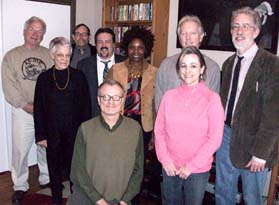 Earlier in the day, trustee Tony Rager
gathered the BMF consultants for a
pre-opening lunch and meeting at Lazlo’s
restaurant and brewpub, directly across
the street from The Burkholder. They had
come from as far away as San Francisco
(Wade Wright) and New York City (Russ
Dantzler), as well as
Fayetteville, Ark. (Kay Davis), Pueblo, Colo.
(Dan DeMuth),
Kansas City, Mo. (Gerald and Leslie
Spaits), and Lincoln (Grace
Sankey-Berman and Tom Ineck. All had
been close, trusted friends of founder
Butch Berman, so it was with mixed
feelings of joy and sorrow that we
shared a meal and conversation that
often involved fond reminiscences of
Butch.
Earlier in the day, trustee Tony Rager
gathered the BMF consultants for a
pre-opening lunch and meeting at Lazlo’s
restaurant and brewpub, directly across
the street from The Burkholder. They had
come from as far away as San Francisco
(Wade Wright) and New York City (Russ
Dantzler), as well as
Fayetteville, Ark. (Kay Davis), Pueblo, Colo.
(Dan DeMuth),
Kansas City, Mo. (Gerald and Leslie
Spaits), and Lincoln (Grace
Sankey-Berman and Tom Ineck. All had
been close, trusted friends of founder
Butch Berman, so it was with mixed
feelings of joy and sorrow that we
shared a meal and conversation that
often involved fond reminiscences of
Butch.![Framed drawing of Butch Berman as "Jazz Santa" oversees the main room. [Photo by Richard S. Hay]](media/709grandopen19.jpg) That sentiment was confirmed when doors
opened to the public at 7 p.m. and
visitors began to arrive in waves,
swelling to a critical mass about 8:30
p.m. and dwindling to a few friends and
jazz enthusiasts after the doors had
officially closed at 9 p.m.
That sentiment was confirmed when doors
opened to the public at 7 p.m. and
visitors began to arrive in waves,
swelling to a critical mass about 8:30
p.m. and dwindling to a few friends and
jazz enthusiasts after the doors had
officially closed at 9 p.m.
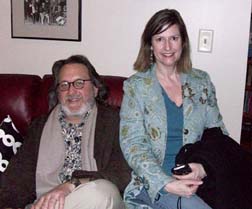
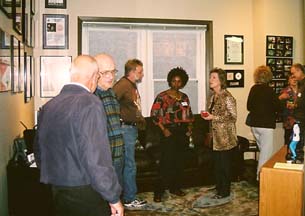
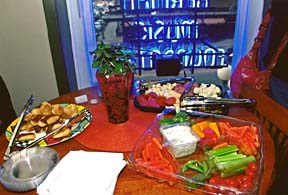
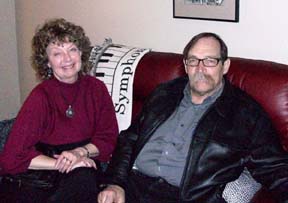
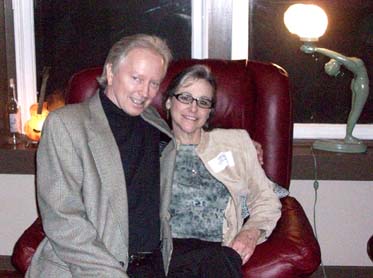
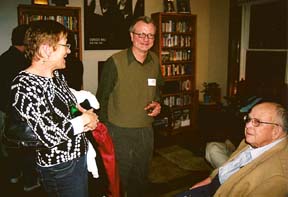
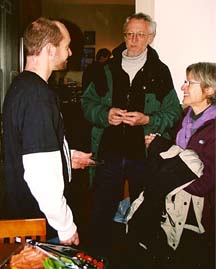
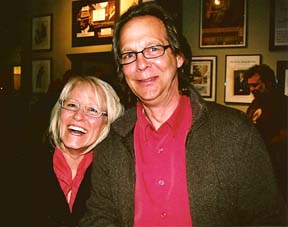
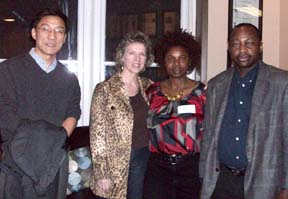
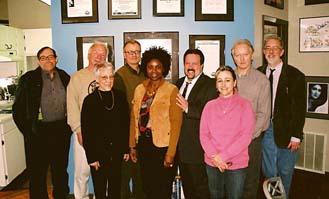
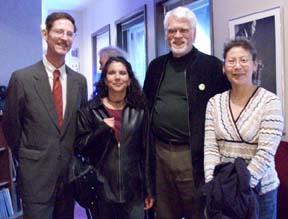
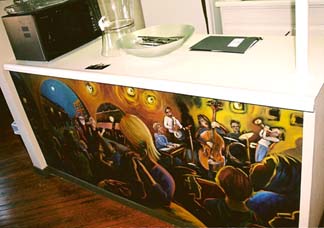
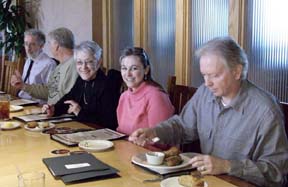
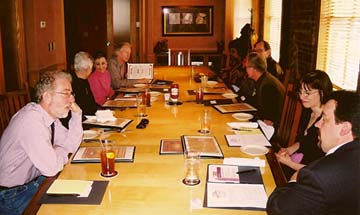
![Project Omaha and friends gather for portrait. [Photo by Tom Ineck]](media/709receptionomaha.jpg) Haymarket
District. Local artists, friends of jazz and fans also were invited.
Among those who attended were Ed Love, music director of the Nebraska
Jazz Orchestra, and his lovely wife, Loretta, coordinator of Jazz in
June Martha Florence, Lincoln jazz keyboardist John Carlini, Sheldon
Museum of Art collections curator Sharon Kennedy, Sheldon events
coordinator Laurie Sipple, Star City Blog publisher Dennis Kornbluh and
his father, David, and friends and fans like Ruthann Nahorny and
Mary Berry.
Haymarket
District. Local artists, friends of jazz and fans also were invited.
Among those who attended were Ed Love, music director of the Nebraska
Jazz Orchestra, and his lovely wife, Loretta, coordinator of Jazz in
June Martha Florence, Lincoln jazz keyboardist John Carlini, Sheldon
Museum of Art collections curator Sharon Kennedy, Sheldon events
coordinator Laurie Sipple, Star City Blog publisher Dennis Kornbluh and
his father, David, and friends and fans like Ruthann Nahorny and
Mary Berry.![Kendra Shank Quartet (from left) Frank Kimbrough, Tony Moreno, Kendra and Dean Johnson [Photo by Tom Ineck]](media/709receptionshank.jpg) music
room. Drummer and percussionist Oscar Dezoto said he remembered every
song on the album, even though he did not play on it. I enjoyed
listening to Dezoto talk about the various people he has played with
over the years, including an African musician from Senegal.
music
room. Drummer and percussionist Oscar Dezoto said he remembered every
song on the album, even though he did not play on it. I enjoyed
listening to Dezoto talk about the various people he has played with
over the years, including an African musician from Senegal.![Grace Sankey-Berman and Victor Lewis [Photo by Devrah Lehner]](media/709receptionomaha3.jpg) get
over how vast the music collection is, and he kept saying, “This is
nuts!” as he looked through the records.
get
over how vast the music collection is, and he kept saying, “This is
nuts!” as he looked through the records.![Luigi Waites and Joanne Klein [Photo by Tom Ineck]](media/709receptionomaha2.jpg) Victor’s
friend from Omaha the great musician Luigi Waites also attended.
Watching the interaction between the two artists was priceless. They
seemed to enjoy each other’s company. Percussionist Joey Gulizia said
there was so much music he would like to come back sometime to have a
better look. We like to hear that because the collection is a great
resource and we encourage musicians and educators to take advantage of
it.
Victor’s
friend from Omaha the great musician Luigi Waites also attended.
Watching the interaction between the two artists was priceless. They
seemed to enjoy each other’s company. Percussionist Joey Gulizia said
there was so much music he would like to come back sometime to have a
better look. We like to hear that because the collection is a great
resource and we encourage musicians and educators to take advantage of
it.
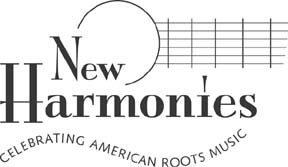 Through
its Museum on Main Street program, the Smithsonian makes specially
designed traveling exhibitions available only through state humanities
councils. By year’s end, “New
Harmonies” will have visited six communities in Nebraska, completing the
state tour with a stay Oct. 18 through Dec. 31 at Loves Jazz & Arts
Center in Omaha. It will be at the Trails and Rails Museum in Kearney
July 30-Aug. 29 and at the Cherry County Historical Society Museum in
Valentine Sept. 3-Oct. 11. Earlier this year, it had extended runs in
Alliance, Cambridge and Columbus.
Through
its Museum on Main Street program, the Smithsonian makes specially
designed traveling exhibitions available only through state humanities
councils. By year’s end, “New
Harmonies” will have visited six communities in Nebraska, completing the
state tour with a stay Oct. 18 through Dec. 31 at Loves Jazz & Arts
Center in Omaha. It will be at the Trails and Rails Museum in Kearney
July 30-Aug. 29 and at the Cherry County Historical Society Museum in
Valentine Sept. 3-Oct. 11. Earlier this year, it had extended runs in
Alliance, Cambridge and Columbus.!["New Harmonies" celebrates American music, including the blues and jazz. [Courtesy Photo]](media/709harmoniesoswald.jpg) and records
the histories of peoples from Africa, Europe, Asia and the Americas.
"New Harmonies" explores how our country’s ongoing cultural process has
made America the birthplace of great music—from jazz and blues to
country western, folk and gospel.
and records
the histories of peoples from Africa, Europe, Asia and the Americas.
"New Harmonies" explores how our country’s ongoing cultural process has
made America the birthplace of great music—from jazz and blues to
country western, folk and gospel.![Gospel singer Mahalia Jackson [Courtesy Photo]](media/709harmoniesmahalia.jpg) Yager said
such sponsorships also allow the NHC to provide a stipend to each museum
to help them to promote the exhibition, arrange special programming
related to the topic of the exhibition, and create a complimentary
exhibit of local interest. Among the goals of Museum on Main Street are
to help small museums build their visitor base and membership, and help
them increase their capacity to develop exhibits, marketing and
programming.
Yager said
such sponsorships also allow the NHC to provide a stipend to each museum
to help them to promote the exhibition, arrange special programming
related to the topic of the exhibition, and create a complimentary
exhibit of local interest. Among the goals of Museum on Main Street are
to help small museums build their visitor base and membership, and help
them increase their capacity to develop exhibits, marketing and
programming.
![Wade Wright and Terri Hinte outside Cafe Divine [Photo by Tom Ineck]](media/709tomfoolery1.jpg) So
it is every couple of years, when I fly—or occasionally drive—from
Nebraska to Northern California. In late May, I
touched down at the San Francisco International Airport in time to pick
up my rental car and have a leisurely lunch in the city with friends
before heading further north. Wade Wright, a Berman Music Foundation
advisor and manager of Jack’s Record Cellar in the city, also helps his
brother at Café Divine, where “heavenly cuisine” is the byword. Butch
Berman recommended the place in a column he wrote several years ago,
and I wanted to check it out in person.
So
it is every couple of years, when I fly—or occasionally drive—from
Nebraska to Northern California. In late May, I
touched down at the San Francisco International Airport in time to pick
up my rental car and have a leisurely lunch in the city with friends
before heading further north. Wade Wright, a Berman Music Foundation
advisor and manager of Jack’s Record Cellar in the city, also helps his
brother at Café Divine, where “heavenly cuisine” is the byword. Butch
Berman recommended the place in a column he wrote several years ago,
and I wanted to check it out in person.![Terri Hinte and Tom Ineck finally meet outside Cafe Divine. [Photo by Wade Wright]](media/709tomfoolery5.jpg) managing
the career of saxophonist Sonny Rollins. As a jazz writer, I had
corresponded with Terri by mail and e-mail for some 25 years, but we had
never met until now.
managing
the career of saxophonist Sonny Rollins. As a jazz writer, I had
corresponded with Terri by mail and e-mail for some 25 years, but we had
never met until now. ![Nikki Farrer enjoying the 2009 Healdsburg Jazz Festival [Photo by Tom Ineck]](media/709tomfoolery2.jpg) original
19th century buildings still stand, including the Union
Hotel, built in 1879. Today it houses one of the best Italian
restaurants in the region, and its saloon is a favorite watering hole
for area residents. Just across the street is Negri’s, which combines
Italian cuisine with a lively bar and occasional live music.
original
19th century buildings still stand, including the Union
Hotel, built in 1879. Today it houses one of the best Italian
restaurants in the region, and its saloon is a favorite watering hole
for area residents. Just across the street is Negri’s, which combines
Italian cuisine with a lively bar and occasional live music.![Joe Phillips, Jobee Farrer and Nikki Farrer at the Palette Art Cafe [Photo by Tom Ineck]](media/709tomfoolery3.jpg) It
certainly helps that we are all inquisitive, broad-minded fans of music,
from rock to jazz to world music. That love of music has long been our
common ground, so it’s a joy when we can share live performances.
It
certainly helps that we are all inquisitive, broad-minded fans of music,
from rock to jazz to world music. That love of music has long been our
common ground, so it’s a joy when we can share live performances.![Wildflower on the rugged coast above Bodega Bay [Photo by Tom Ineck]](media/709tomfoolery4.jpg) On
my final full day in the area, Joe and I took a road trip to another
favorite place, the rugged, beautiful coast at Bodega Bay, where Alfred
Hitchcock filmed much of “The Birds.” It was a glorious spring day, so
we hiked the hillsides above the bay, which were profuse with aromatic
wildflowers. It was the perfect end to another memorable stay.
On
my final full day in the area, Joe and I took a road trip to another
favorite place, the rugged, beautiful coast at Bodega Bay, where Alfred
Hitchcock filmed much of “The Birds.” It was a glorious spring day, so
we hiked the hillsides above the bay, which were profuse with aromatic
wildflowers. It was the perfect end to another memorable stay.
![Shank at 2007 Jazz in June performance [File Photo]](media/707shank1.jpg) Shank’s
June 16 concert was her quartet’s
third at the outdoor venue, having
previously performed in 2004 and 2007.
The singer first appeared on a Lincoln
stage way back in 1995, when the Berman
Music Foundation brought her to the Zoo
Bar as part of an all-star lineup that
included Claude “Fiddler” Williams,
pianist Jaki Byard, bassist Earl May and
drummer Jackie Williams.
Shank’s
June 16 concert was her quartet’s
third at the outdoor venue, having
previously performed in 2004 and 2007.
The singer first appeared on a Lincoln
stage way back in 1995, when the Berman
Music Foundation brought her to the Zoo
Bar as part of an all-star lineup that
included Claude “Fiddler” Williams,
pianist Jaki Byard, bassist Earl May and
drummer Jackie Williams. ![The Kendra Shank Quartet at Jazz in June 2007 [File Photo]](media/707shank6.jpg) creative
ideas, so I just let them express
themselves. That’s the whole point. Jazz
is an improvisational art form, so let
that happen. That’s what makes this
music exciting. You’ve got four people,
each of which has their own life
experience and their own personality and
their own technical ability and their
own harmonic sense and rhythmic sense.
So each person has something really
valuable to contribute.”
creative
ideas, so I just let them express
themselves. That’s the whole point. Jazz
is an improvisational art form, so let
that happen. That’s what makes this
music exciting. You’ve got four people,
each of which has their own life
experience and their own personality and
their own technical ability and their
own harmonic sense and rhythmic sense.
So each person has something really
valuable to contribute.”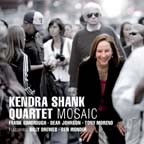 original
improvisation “Reflections in Blue,” and
Charlie Chaplin’s forlorn “Smile” is
ingeniously combined with “Laughing at
Life.” Kimbrough’s own “For Duke” is
endowed with a beautiful lyric of love
by his wife, composer, vocalist and poet
Maryanne De Prophetis.
original
improvisation “Reflections in Blue,” and
Charlie Chaplin’s forlorn “Smile” is
ingeniously combined with “Laughing at
Life.” Kimbrough’s own “For Duke” is
endowed with a beautiful lyric of love
by his wife, composer, vocalist and poet
Maryanne De Prophetis.
![Ray Gehring [Courtesy Photo]](media/709gehring2.jpg) LINCOLN,
Neb.—Guitarist Ray Gehring has
proved that you CAN go home again. He
traveled with his band from Brooklyn,
N.Y., for gigs May 20 in Minneapolis,
May 21 at the Saddle Creek Bar in Omaha
and May 22 at the Zoo Bar in Lincoln,
the city where he spent his formative
years as a music fan and a fledgling
musician.
LINCOLN,
Neb.—Guitarist Ray Gehring has
proved that you CAN go home again. He
traveled with his band from Brooklyn,
N.Y., for gigs May 20 in Minneapolis,
May 21 at the Saddle Creek Bar in Omaha
and May 22 at the Zoo Bar in Lincoln,
the city where he spent his formative
years as a music fan and a fledgling
musician. 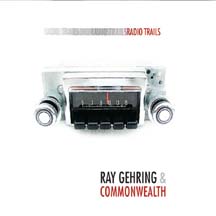 Even
in his jazz songwriting, Gehring began
to hear evidence of his immersion in
1970s pop-culture radio and TV.
Even
in his jazz songwriting, Gehring began
to hear evidence of his immersion in
1970s pop-culture radio and TV.
![The Bad Plus with singer Wendy Lewis (left) [Courtesy Photo]](media/709badplus1.jpg) On
their latest venture, “For All I Care,”
pianist Ethan Iverson, bassist Reid
Anderson and drummer Dave King have
taken another bold leap forward by
adding vocalist Wendy Lewis on a
recording that eschews original material
for a mix of classic pop songs by
artists ranging from Nirvana and the Bee
Gees to Pink Floyd and Roger Miller.
Tastefully sprinkled among these tracks,
as though they were “palate cleansers,”
are the band’s unique instrumental
interpretations of modern classical
melodies by Igor Stravinsky, Gyorgy
Legeti and Milton Babbitt.
On
their latest venture, “For All I Care,”
pianist Ethan Iverson, bassist Reid
Anderson and drummer Dave King have
taken another bold leap forward by
adding vocalist Wendy Lewis on a
recording that eschews original material
for a mix of classic pop songs by
artists ranging from Nirvana and the Bee
Gees to Pink Floyd and Roger Miller.
Tastefully sprinkled among these tracks,
as though they were “palate cleansers,”
are the band’s unique instrumental
interpretations of modern classical
melodies by Igor Stravinsky, Gyorgy
Legeti and Milton Babbitt.